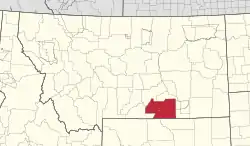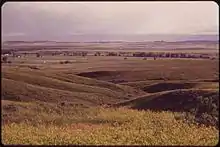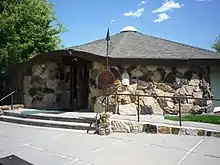Crow Indian Reservation
The Crow Indian Reservation (est. 1868)[3][4] is the homeland of the Crow Tribe of Indians of the State of Montana in the United States. The reservation is located in parts of Big Horn, Yellowstone, and Treasure counties in southern Montana. It has a land area of 3,593.56 sq mi (9,307.27 km²) and a total area of 3,606.54 sq mi (9,340.89 km²), making it either the fifth or sixth largest reservation in the country. (Rankings are switched with the Standing Rock Indian Reservation depending on whether water areas are counted.) Reservation headquarters are in Crow Agency.
Crow Indian Reservation | |
|---|---|
 Flag | |
 Location in Montana | |
| Tribe | Crow (Apsáalooke) |
| Country | United States |
| State | Montana |
| Counties | Big Horn Treasure Yellowstone |
| Established | May 7, 1868 |
| Headquarters | Crow Agency |
| Government | |
| • Body | Crow Tribe Executive Branch |
| • Chairman | Alvin Not Afraid Jr. (R) |
| • Vice-Chairman | Carlson Goes Ahead |
| Area | |
| • Total | 3,606.54 sq mi (9,340.9 km2) |
| • Land | 3,593.56 sq mi (9,307.3 km2) |
| Population (2017)[2] | |
| • Total | 7,096 |
| • Density | 2.0/sq mi (0.76/km2) |
| Website | crow-nsn.gov |


The Crow Tribe of Indians of the State of Montana has an enrolled tribal membership of approximately 11,000, of whom 7,900 reside on the Crow Indian Reservation. Eighty-five percent speak Crow as their first language.
The Crow Indian Reservation, the largest of the seven Indian reservations in Montana, is located in south-central Montana, bordered by Wyoming to the south and the Northern Cheyenne Indian Reservation to the east. The reservation encompasses approximately 2,300,000 acres (9,300 km2),[5] which includes the northern end of the Bighorn Mountains, Wolf Mountains, and Pryor Mountains. The Bighorn River flows north from the Montana-Wyoming state line, journeying north to the Little Bighorn River just outside Hardin, Montana. Part of the reservation boundary runs along the ridgeline separating Pryor Creek and the Yellowstone River. The city of Billings is approximately 10 miles (16 km) northwest of this reservation boundary.
The PBS TV series Reading Rainbow partially filmed its tenth episode "The Gift of the Sacred Dog" here on June 17, 1983. The title was based on a book by Paul Goble and was narrated by actor Michael Ansara.
History
The reservation is located in old Crow country. Already in August 1805, fur trader Francois-Antoine Larocque camped at the Little Bighorn River and travelled part of the area with a Crow group.[6]
The reservation is a segment at the center of the 1851 Crow Indian territory as described in the Fort Laramie treaty.[7]
Pressure from the whites north of Yellowstone River and a Lakota (Sioux) invasion into Crow treaty guaranteed land from the east (the lead up to Red Cloud's War)[8] made the 1860s a trying time for the Crow. "Oglalas under Crazy Horse and Red Cloud and Hunkpapas and Minneconjous under Sitting Bull continued to follow the dwindling buffalo herds west from the Powder River, while gold seekers travelled north into the [Crow] region along the Bozeman [Trail] ...". Steamboats on the Missouri River brought an additional number of prospectors into the Yellowstone area.[9] The situation called for a new Crow treaty.
On May 7, 1868, the Crow sold around 30 million acres of their 1851 territory and accepted to live in a reservation.[10] The border to the south was the 45th degree of north latitude, while the 107th degree of longitude west was the eastern border. Both borderlines met the Yellowstone at a point. The connection of these two points followed the course of the river and made up the last border of the 1868 reservation.[11] It comprised about eight million acres.[10]
Major F. D. Pease got the position as the first Civil Agent at the Crow reservation, from 1870-1874.[12]
Land cessions to the United States approved in 1882, 1892 and finally in 1906 cut the western and the northernmost part of the 1868 reservation.[13]
Crow chief Plenty Coups, the schooled Robert Yellowtail and others stopped the efforts to open the reservation in 1917. In a hotel room in Washington, D.C., they opened a powerful bundle over the incense of buffalo chips from animals in the National Zoo and prayed for help. "The next day the attempted appropriation of their land was soundly defeated".[14]
Robert Yellowtail made captions, when he became superintendent of his own tribe's reservation in 1934, the first Indian to do so.[15]
The Crow reservation got its present shape after moderate land cuts in 1937 and in connection with the construction of the Bighorn Canyon Dam in the 1960s.[16]
Also during the 1960s, the first woman served the Crow reservation as tribal official, namely Pauline Small.[17]
The value of the enormous amount of coal hidden under the surface in the old tribal territory became clear to the reservation Crows after the Arab Oil Embargo in the 1970s.[18] The Crow Nation owns 1.4 billion tons of coal, enough to match the total supply in the United States for a year.[19] The reservation's Absaloka coal mine provides half of the tribe's nonfederal budget.[20] The single-pit mine opened in 1974 and employs 170 people.[20] The decline of coal mining in the United States has forced the tribe to lay off 1,000 of its 1,300 employees.[20] Every tribal citizen receives a $225 coal payment every four months.[20] Half of the reservation's adult population is unemployed.[19]
In 2013, the tribe and Cloud Peak Energy agreed to open the Big Metal mine, which would have brought the company $10 million in revenue over the first five years.[20] President Barack Obama blocked the mine and then imposed a moratorium on any new coal leasing on public lands.[20] In March 2017, the Northern Cheyenne Indian Reservation sued Interior Secretary Ryan Zinke to stop his attempt to lift the moratorium.[20]
_as_described_in_Fort_Laramie_treaty_(1851)%252C_present_Montana_and_Wyoming.png.webp) Crow Indian territory (area 517, 619 and 635) as described in Fort Laramie treaty (1851), present Montana and Wyoming
Crow Indian territory (area 517, 619 and 635) as described in Fort Laramie treaty (1851), present Montana and Wyoming._Yellow_area_517_is_1851_Crow_treaty_land_ceded_to_the_U.S.png.webp) Crow Indian Reservation, 1868 (area 619 and 635). Yellow area 517 is 1851 Crow treaty land ceded to the U.S
Crow Indian Reservation, 1868 (area 619 and 635). Yellow area 517 is 1851 Crow treaty land ceded to the U.S._Area_619_ceded.png.webp) Crow Indian Reservation, 1880 (area 635). Area 619 ceded. Ratified 1882.
Crow Indian Reservation, 1880 (area 635). Area 619 ceded. Ratified 1882.._Area_714_ceded.png.webp) Crow Indian Reservation, 1891 (area 715). Area 714 ceded. Approved 1892. (Area 658 is the Northern Cheyenne Indian Reservation in old Crow territory.)
Crow Indian Reservation, 1891 (area 715). Area 714 ceded. Approved 1892. (Area 658 is the Northern Cheyenne Indian Reservation in old Crow territory.)
Communities
Historic places and attractions
The number one attraction in the Crow reservation is the Little Bighorn National Monument. Unwanted Lakotas and Northern Cheyennes defeated the Seventh Cavalry under George Armstrong Custer here on June 25, 1876. Local Crow scouts defending their reservation guided Custer.[21]
Chief Plenty Coups (Alek-Chea-Ahoosh) State Park and Home is located near the town of Pryor. It has a small museum dedicated to chief Plenty Coups and the Crow tribe. The chief's two floors lodge house (and at the same time grocery store) is preserved.[22]
Notable events
For more than 100 years, since 1904, the Crow have organized the big Crow Fair, forming the "Teepee Capital of the World". By tradition it is held the third week in August.[23]
References
- "Crow Tribe of Indians". Retrieved 2019-07-24.
- 2013-2017 American Community Survey 5-Year Estimates. "My Tribal Area". United States Census Bureau.
- Charles J. Kappler, ed. (1904), "Montana: Crow Reserve", Indian Affairs: Laws and Treaties, Washington, DC: Government Printing Office
- David J. Wishart, ed. (2004). "Native Americans: Crows". Encyclopedia of the Great Plains. University of Nebraska Press. ISBN 0-8032-4787-7.
- Lopard, James J., Margery Hunter Brown and Richmond L. Clow: Tribal Government Today. Politics on Montana Indian Reservations. Boulder, San Francisco, & London, 1990, acres p. 57.
- Wood, Raymond W. and Thomas D. Thiessen: Early Fur Trade on the Northern Plains. Canadian Traders Among the Mandan and Hidatsa Indians, 1738-1818. Norman and London, 1987, p. 184.
- Kappler, Charles J.: Indian Affairs. Laws and Treaties. Washington, 1904. Vol. 2, p. 594.
- Hoxie, Frederick E.: Parading Through History. The making of the Crow Nation in America, 1805-1935. Cambridge, 1995, p. 89. See also Rzeczkowski, Frank: The Crow Indians and the Bozeman Trail. Montana, The Magazine of Western History, Vol. 49, No. 4 (1999), pp. 30-47. Utley, Robert M.: The Bozeman Trail before John Bozeman: A busy Land.Montana, The Magazine of Western History, Vol. 53, No. 2 (2003), pp. 20-31.
- Hoxie, Frederick E.: Parading Through History. The making of the Crow Nation in America, 1805-1935. Cambridge, 1995, p. 97.
- Hoxie, Frederick E.: Parading Through History. The making of the Crow Nation in America, 1805-1935. Cambridge, 1995, p. 92.
- Kappler, Charles J.: Indian Affairs. Laws and Treaties. Washington, 1904. Vol. 2, p. 1008.
- Pease, Eloise Whitebear (Ed.): Absaraka. Crow Tribal Treaty Centennial Issue. Billings, 1968, p. 17.
- Kappler, Charles J.: Indian Affairs. Laws and Treaties. Washington, 1904. Vol. 1, pp. 195-197 (1882); Vol. 1, pp. 958-967 (1892) and Vol. 3, pp. 614-618 (1906).
- Viola, Herman J.: Diplomats in Buckskins. A History of Indian Delegations in Washington City. Washington, D.C., 1981, p. 147.
- Poten, Constance J.: Robert Yellowtail, the New Warrior. Montana, The Magazine of the West, Vol. 39 (Summer 1989), pp. 36–41, p. 38.
- Pease, Eloise Whitebear (Ed.): Absaraka. Crow Tribal Treaty Centennial Issue. Billings, 1968, p. 56.
- Pease, Eloise Whitebear (Ed.): Absaraka. Crow Tribal Treaty Centennial Issue. Billings, 1968, p. 21.
- Poten, Constance J.: Robert Yellowtail, the New Warrior. Montana, The Magazine of the West, Vol. 39 (Summer 1989), pp. 36–41, p. 40–41.
- Krauss, Clifford (15 June 2013). "Coal Industry Pins Hopes on Exports as U.S. Market Shrinks". The New York Times. p. A1. Retrieved 4 April 2017.
- Turkewitz, Julie (2 April 2017). "Tribes That Live Off Coal Hold Tight to Trump's Promises". The New York Times. p. A1. Retrieved 4 April 2017.
- Dunlay, Thomas W.: Wolves for the Blue soldiers. Indian Scouts and Auxiliaries with the United States Army, 1860-1890. Lincoln and London, 1982, pp. 113-114.
- Linderman, Frank B.: Plenty Coups. Chief of the Crows. Lincoln/London, 1962, pp. 239-240, (for other editions of the book, find pages in Index about "Mount Vernon".). McRae, W. C. and Judy Jewell: Montana Handbook. Hong Kong, 1992, p. 80.
- Medicine Crow, Joseph: From the Heart of the Crow Country. The Crow Indians' own Stories. New York, 1992, pp. 119-123.
